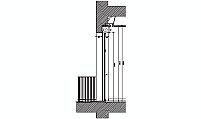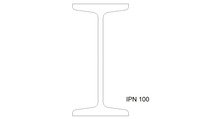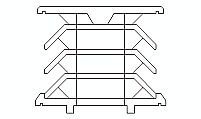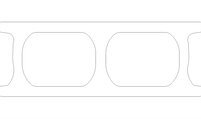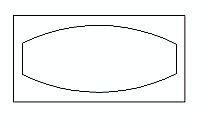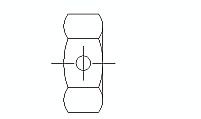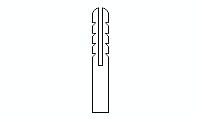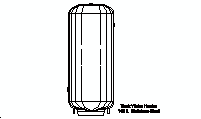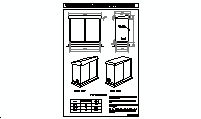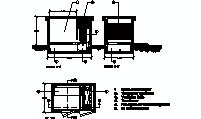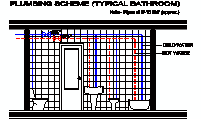CAD Blocks categories
 3D models
3D models home furniture
home furniture sanitary ware - bathrooms
sanitary ware - bathrooms professional equipment
professional equipment doors and windows
doors and windows people and animals
people and animals plants and trees
plants and trees vehicles - transports
vehicles - transports architectural details
architectural details mechanical - electrical
mechanical - electrical urban planning - civil works
urban planning - civil works safety health construction
safety health construction accessible design
accessible design drawing sheet
drawing sheet signals
signals construction machinery
construction machinery accessories and objects
accessories and objects maps and street maps
maps and street maps
Decorative Concrete Lattice Block - DWG Design

size: 5 kb
category: architectural details
related categories:
description: Front view of a decorative concrete lattice block with symmetrical curved openings, often used as a decorative element in fence top rows.
file extension: .dwg CAD - AutoCAD software
Features and Uses of Decorative Concrete Lattice Blocks
Characteristics of Decorative Concrete Lattice Blocks
Decorative concrete lattice blocks are crafted with geometric or organic patterns, such as the symmetrical curved openings in the image, resembling a leaf design. These blocks serve both functional and aesthetic purposes. The open spaces allow light and air to pass through, making them ideal for creating partitions or ventilated walls. Commonly made from reinforced concrete, they provide durability while maintaining a decorative appearance.
This particular design is often used as a fence top decorative finish or in garden walls. The curved openings in a symmetrical pattern add elegance and artistic appeal to any project. Decorative lattice blocks are versatile and can complement both modern and traditional architectural styles.
Common Dimensions and Materials of Lattice Blocks
Decorative concrete lattice blocks are typically available in standard sizes to match the modular construction approach. Common dimensions include 16 x 16 inches (40 x 40 cm), 16 x 8 inches (40 x 20 cm), or custom sizes depending on manufacturer specifications. The material is predominantly a mix of Portland cement, sand, and gravel, providing strength and resistance to environmental factors.
Blocks like the one shown in the image often feature smooth or textured finishes. These blocks are manufactured according to standards like ASTM C129 for non-load-bearing concrete masonry units, ensuring durability and consistent quality across different applications.
Installation Techniques for Decorative Lattice Blocks
- How are lattice blocks installed?
- Lattice blocks are laid with mortar joints, usually 3/8 inches thick, ensuring alignment and stability. They are often installed on the final row of walls or fences for aesthetic purposes.
- What type of foundation is required?
- A reinforced concrete base or beam is essential to provide structural support for the lattice blocks, especially when used as fence toppers.
- Are reinforcement bars required?
- Reinforcement bars may be added during installation to improve stability and durability in taller structures or high-wind areas.
- Can they be painted or finished?
- Yes, decorative lattice blocks can be painted, coated, or left with their natural concrete finish depending on the desired look and project requirements.
- How do you handle moisture protection?
- Blocks should be treated with a waterproofing sealant or installed with proper drainage systems to prevent moisture absorption over time.
Advantages of Decorative Lattice Blocks
Decorative concrete lattice blocks provide both functionality and beauty. Their design allows for natural ventilation and light filtration, making them ideal for warm climates or enclosed spaces where airflow is needed. Additionally, their durable concrete material resists wear and tear, ensuring a long lifespan even in outdoor applications.
These blocks also offer environmental benefits, as they are made from eco-friendly materials and often incorporate recycled aggregates. Their lightweight and modular nature enable quick installation, reducing labor costs and project timelines. Furthermore, the variety of designs, such as the leaf-like pattern shown here, enhances architectural aesthetics.
History and Variations in Decorative Lattice Blocks
Decorative lattice blocks originated in the mid-20th century as a design innovation for enhancing the functionality of walls. Initially popular in tropical and subtropical climates, they allowed for natural cooling and ventilation in buildings. Today, they are widely used across various architectural styles, blending function and beauty.
Variations of decorative lattice blocks include geometric, floral, and abstract patterns, catering to diverse design preferences. For instance, geometric patterns are commonly used in modern constructions, while floral motifs are favored for traditional or classic settings. Globally, similar blocks are referred to as breeze blocks or vent blocks, with regional adaptations to suit local climates and materials.



